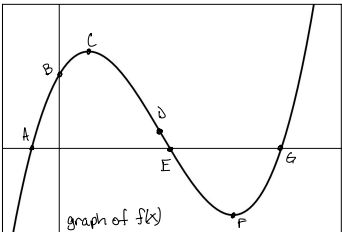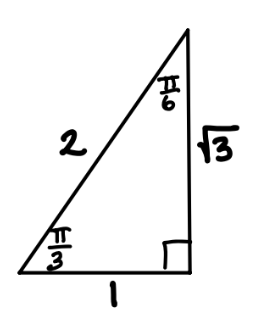Stuff to Know Cold for AP Precalculus
1/107
There's no tags or description
Looks like no tags are added yet.
Name | Mastery | Learn | Test | Matching | Spaced |
|---|
No study sessions yet.
108 Terms

concavity and rate of change from (-∞, D)
concave down, decreasing

concavity and rate of change from (D, ∞)
concave up, increasing

Describe f(x) on the interval (C, F)
function is decreasing and the rate of change is negative

Describe f(x) on the interval (F, ∞)
function is increasing and the rate of change is positive

Is the function positive or negative on the interval (A, E)?
positive

Is the function positive or negative on the interval (E, G)?
negative
Describe change patterns in a linear function.
rate of change is constant on any interval
Describe change patterns in a quadratic function.
the 2nd differences are constant over equal length input intervals
Describe change patterns in a polynomial function with degree n.
nth differences of output values are constant over equal length input intervals
Describe change patterns in an exponential function.
output values are proportional over equal length input intervals
Describe change patterns in a logarithmic function.
proportional input values result in constant change in output values
What is the average rate of change of f(x) over the interval [A, B]?
slope of the line between the points
f(b) - f(a)/b-a
What is rate of change?
refers to slope AT THAT POINT

verbalize this
As the input value increases without bound, the output value approaches 3. (graph has a horizontal asymptote at y = 3)

verbalize this
As the input values decrease without bound, the output values increase without bound.

f(a) —>
0/0 (hole)

f(b) —>
#/0 (x-intercept)
f(c ) —>
0/# (VERTICAL asymptote)

if m < n


if m = n


if m > n


vertical stretch if
|a| > 1

vertical compression if
|a| < 1

reflection over x-axis if
a is negative

horizontal stretch if
|b| < 1

horizontal compression if
|b| > 1

reflection over y-axis if
b is negative











1











0

n
arithmetic sequence formula

geometric sequence formula

inverse functions numerically
f(a) = b then f-1(b) = a
inverse functions graphically
inverse of f(x) is f(x) reflected over the line y = x
how to solve for inverse function algebraically
switch y and x and solve
inverse function verbally

sin(x)
y/r
cos(x)
x/r
tan(x)
y/x
30-60-90 triangle

45-45-90 triangle

domain of arcsin
[-1,1]
range of arcsin
[-pi/2, pi/2] quadrants 1 and 4
domain of arccos
[-1,1]
range of arccos
[0, pi] quadrants 2 and 3
domain of arctan
[-∞, ∞]
range of arctan
[-pi/2, pi/2] quadrants 1 and 4
AROC on interval [a, b] with points (a, f(a)) and (b, f(b))

secant line
line formed between points a and b using the AROC formula

f(x) ___, ROC is ___, curve is ___
decreases, increasing, concave up

f(x) ___, ROC is ___, curve is ___
increases, increasing, concave up

f(x) ___, ROC is ___, curve is ___
decreases, decreasing, concave down

f(x) ___, ROC is ___, curve is ___
increases, idecreasing, concave down
if a polynomial function is increasing…
ROC is positive
if a polynomial function is decreasing…
ROC is negative
if a polynomial function is concave up…
ROC is increasing
if a polynomial function is concave down…
ROC is decreasing
point of inflection
ROC changes from increasing to decreasing or vice versa (CHANGE IN CONCAVITY)
odd function
f(-x) = -f(x) passes through origin
**if you can flip it upside down and it looks the same, it’s likely odd**
even function
f(-x) = f(x)
(x-a)1
crosses x-axis (linearly)
(x-a)2
bounces (quadratically)
(x-a)3
bends (cubically)
if (a + bi) is a factor…
(a - bi) is a factor
end behavior of odd degree functions
opposites
end behavior of even degree functions
same
positive leading coefficient
up on right
negative leading coefficient
down on right

a value


b value


h value


k value

linear function
If both input and output values change consistently
quadratic function
If input changes consistently and the 2nd differences of output values are equal.
cubic function
If input changes consistently and the 3rd differences of output values are equal.
exponential function
If input changes consistently and output values change proportionately
logarithmic function
If input values change proportionately and output values change consistently
is sin(x) odd or even?
odd
is cos(x) odd or even?
even
is tan(x) odd or even?
odd
how to calculate period of function
2∏/b for sin and cos
∏/b for tan
polar to rectangular formulas
x = rcosθ and y = rsinθ
rectangular to polar formulas
x2 + y2 = r2 and tanθ = y/x
r = acosθ

r = a

r = asinθ

domain of circles
[0, 2∏]

a/b = 1


a/b = 1

domain of cardioid
[0, 2∏]